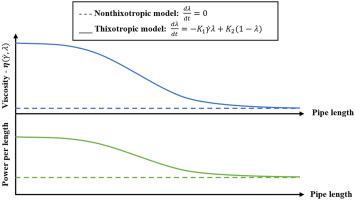Water Research ( IF 11.4 ) Pub Date : 2020-07-07 , DOI: 10.1016/j.watres.2020.116126 Ehsan Farno 1 , Daniel Robert Lester 1 , Nicky Eshtiaghi 1

|
Due to the inherent rheological complexity of wastewater sludges, conventional sludge pipeline design based on simplified rheological models can result in inefficient sludge transportation systems. These inefficiencies are further exacerbated by a global need for the processing of more concentrated wastewater sludges that have a more pronounced non-Newtonian character, and hence require greater energy for transportation. However, the complex rheology of these materials (typically visco-elastic and thixotropic) requires sophisticated methods for constitutive modelling that are impractical to implement for complex materials such as sewerage sludges. We address this challenge by developing a novel viscoplastic thixotropic constitutive model that exploits the separation of timescales between the thixotropic and viscoelastic processes, leading to simpler and more robust experimental methods, parameter estimation and process simulation methods. This constitutive model combines a kinetic model for thixotropic degradation and agglomeration via a classical structural parameter (λ) approach coupled nonlinearly with a Herschel-Bulkley model to yield a thixotropic viscoplastic model of sludge rheology. Experimental data for thickened digested sludge between 3 and 4.9% solids were collected to validate the assumption for the separation of viscoelastic and thixotropic responses. The fitting procedure was found to be robust and efficient, and several rheological parameters were found to be invariant with solids concentration. Simplified energy calculations for a typical sludge pipeline showed that the pumping energy could be significantly under- or overestimated without considering thixotropy. These simple and robust constitutive models and fitting methods can accurately predict (and hence design and optimise) sludge behaviour over a wide range of wastewater processes.
中文翻译:

触变性粘塑性废水污泥的本构模型和管道流量。
由于废水污泥固有的流变复杂性,基于简化流变模型的常规污泥管道设计可能会导致污泥运输系统效率低下。全球对更浓缩的非牛顿性废水污泥的处理需求进一步加剧了这些效率低下的问题,因此需要更多的能源进行运输。但是,这些材料的复杂流变学(通常是粘弹性和触变性)需要用于本构模型的复杂方法,对于复杂的材料(如污水污泥)而言,这是不切实际的。我们通过开发新型的粘塑性触变本构模型来应对这一挑战,该模型利用了触变和粘弹性过程之间的时间尺度分离,导致更简单,更强大的实验方法,参数估计和过程仿真方法。该本构模型通过经典的结构参数结合了触变降解和团聚的动力学模型(λ)方法与Herschel-Bulkley模型非线性耦合,以产生污泥流变学的触变粘塑性模型。收集了固体含量在3%至4.9%之间的增稠消化污泥的实验数据,以验证粘弹性和触变响应分离的假设。发现拟合过程是鲁棒且有效的,并且发现一些流变参数对于固体浓度是不变的。对典型污泥管道的简化能量计算表明,在不考虑触变性的情况下,泵送能量可能会大大低估或高估。这些简单而强大的本构模型和拟合方法可以准确预测(从而设计和优化)各种废水处理过程中的污泥行为。











































 京公网安备 11010802027423号
京公网安备 11010802027423号